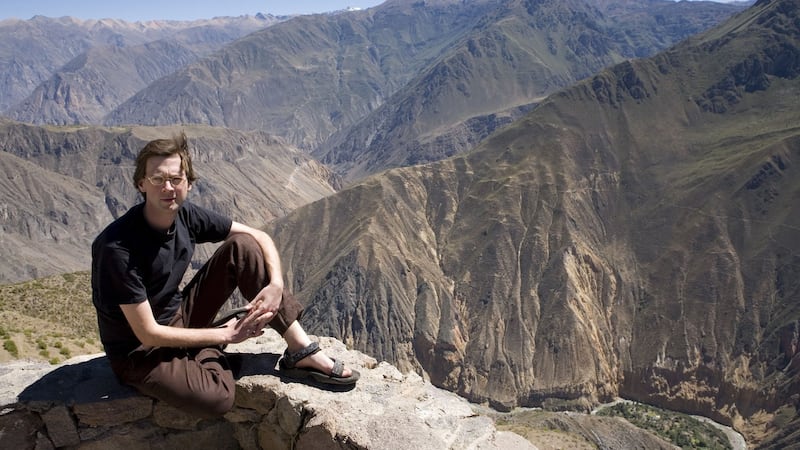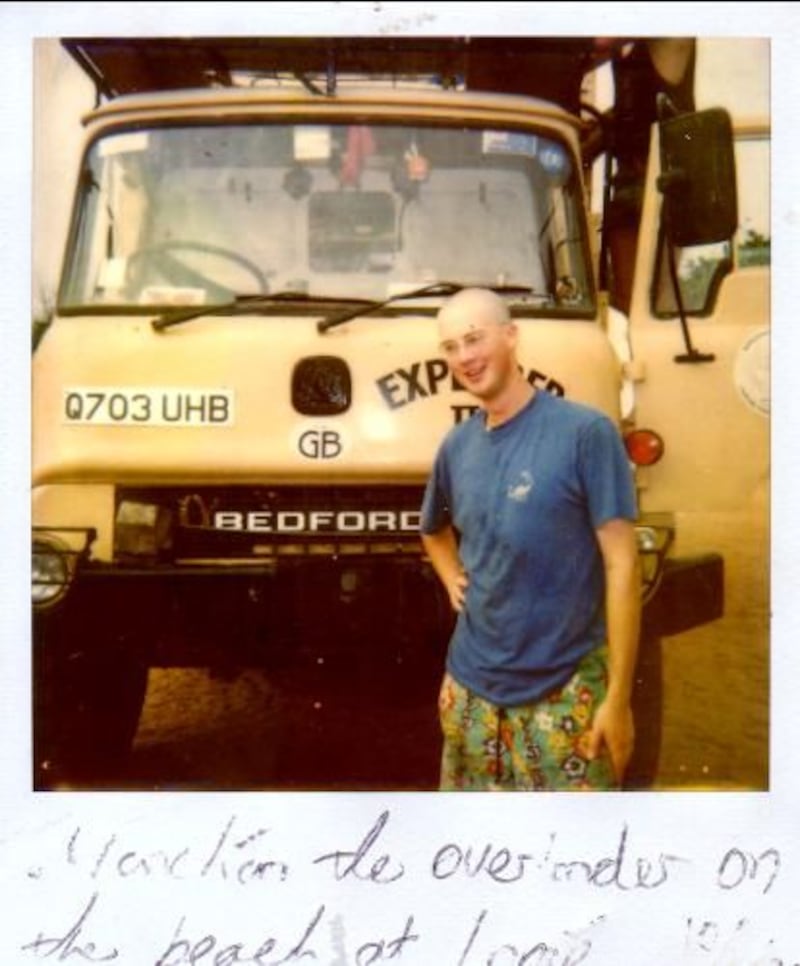Manchán Magan has travelled across Africa in an army truck, almost been shot by the Columbian army, lived "in a hermitage in the Himalayas, drinking my own piss" and once found himself shouting "buail abhaile" to a black bear in British Columbia. (He doesn't know if it worked, because he got nervous and used pepper spray.)
I expected him to suggest we meet by Coumshingaun lake in the Comeraghs or at a bothy in Dingle, but instead he suggests Kinnegad. And so we meet at a cafe on the main road through town.
The reason for Kinnegad is pragmatic: it is accessible to me and within striking distance of home for him, the 10 acres of land he had the foresight to buy in 1997 with £10,000 left to him by his grandmother.
“I rang all the auctioneers in the southeast and I said, ‘I have £10,000. I want to buy 10 acres’. They laughed me out of it. I went to west Cork and east Clare where all the New Age communities were, but they were just a bit too intense for me. Then I rang an auctioneer in Castlepollard and he said, ‘look no further’ ”, he laughs.
My life has been absolutely free, because I don't have a mortgage because I don't need to earn anything.
The house he built on the land he bought in Westmeath was made of straw bales and it was the first of its kind in Ireland. It cost him €6,000 and took six weeks to build. In 2002, when cracks started to appear in the walls, he replaced it with a similarly simple construction of concrete plastered in mud, straw and cement, with a grass roof, this time at a cost of €26,000. He was just doing what he had seen people all over the world do on his travels, he says – build simple homes for themselves using whatever materials they had around them.
"In Tibet, it's stone; in Bolivia, it's reeds, in Africa it's mud, and no one gets a mortgage. That concept of tying yourself and your savings up to a mortgage doesn't exist," he says, over green tea and cake.
“My life has been absolutely free, because I don’t have a mortgage because I don’t need to earn anything.”
He still lives on very little; the fees for a single TV series can see him through for months and months. Given his well-documented wanderlust – although pre-pandemic he had already, in a column in this newspaper in January, sworn off travelling by plane unless absolutely necessary – I wonder how he has coped with lockdown. I needn't have worried. "Lockdown has been brilliant for me," he says. He bought another 10 acres and "finally I've been able to do all the things I wanted on my land. Four years ago, I started growing vegetables, but nothing had been done to the scale or level I wanted it to be."
He has come armed with some of the actual fruits of that labour – a bag of his delicious kale, green beans, cucumbers, and another large leafy veg I haven’t been able to identify. “It’s producing enough food for a village and it’s going to waste unless I give it to people.”
We’re not meeting to talk about self-sufficiency, but his new book, Thirty Two Words for Field: Lost Words of the Irish Landscape, a riproaring, archaeological and anthropological exploration of the lyricism, mystery and oddities of the Irish language, and the layers of ancient knowledge encoded within. You won’t have to speak Irish – you don’t even have to be Irish – to be wholly absorbed by this unique, enchanting book, which has been six years in the research and writing.
We used to spend all our time on breaks, sitting in the bushes, playing these very otherworldly games
He offers, for example, 21 different words for holes, 45 for stones. There are, he reveals, 70,000 Irish place names and more than 4,300 words to describe people’s character. And there are many ways to express the changing qualities of the ocean, light or the wind.
His love of the language came from summers spent on the Blaskets and from his grandmother, Sighle Humphreys, who would pay him and his siblings money for every proverb they learned. The niece of The O’Rahilly and a “bellicose” republican, “she was just desperate to connect us to the Irish language in any way she could, whether it was the political side, the local side or the story side”, he says.

Irish was introduced to him “as a weapon of war”, but what he would grow to love about it were the clues it offered to who we are as people; answers to the existential questions he has been asking himself since childhood.
He was a thoughtful child, who fitted in everywhere and nowhere. His life was split between Donnybrook, where his family home was, and the west Kerry Gaeltacht where he spent chunks of each year. When in Dublin, he went to Mount Anville primary, where his best friends were former Barack Obama adviser Samantha Power and chief executive of the Irish Youth Foundation Lucy Masterson.
“We used to spend all our time on breaks, sitting in the bushes, playing these very otherworldly games. But then I joined Gonzaga” and though it was progressive, there were no girls, and totally different types of games being played. “I just couldn’t understand competing.”
Even as a boy, he was a pacifist, more interested in growing herbs than playing rugby. The political baggage surrounding Irish held no appeal for him. Its magic only came alive when he began to see it as the key to decoding who we are. “We talk about everything about the language, except what is vital about it: that it has preserved this ancient knowledge about being in the world, and our connection with the landscape,” he says.
Now, more than ever, he says, “we are on this desperate search for our psyche; [to know] who the hell am I in this world? It just happens to all be contained within the language. It’s really trippy.”
And it is really trippy – whether he’s talking about how Irish can provide a rich vocabulary to describe lust in animals, throw up insights into what our ancient forebears might have instinctively understood about physics, or allow us to express emotions we don’t even recognise in English, such as “iarmhaireacht, the loneliness you feel at cockcrow, when you are the only person awake and experience that existential pang of disconnection, of not belonging”.
The book was born partly of his frustration with the fact that we keep having the wrong conversations about Irish.
“It was the paucity of arguments about the Irish language that did my head in. We say the same things: it was taught badly in school; it was beaten into me; what’s the use of the Irish language? I realised there’s a million other things to be said about the language, particularly if you look at it through the prism of ancient languages.”

In the book, as well as chapters positing whether the tales of Cú Chulainn might have been inspired by magic mushrooms and a comet, he explores the links between Arabic and Irish (which includes the word for shamrock – seamróg, from seamair/clover, which came from pre-Islamic Pagan Arabic, “shamrakh”, which means “three gods in one leaf”). He also dives into the fascinating connections between Irish and Sanskrit, and the parallels between systems of law, social hierarchy, divine worship and mythology in Irish and Hindu culture.
Of the Irish spoken on the Blaskets, he writes: "It was a form of the language that retained traces of its roots in the Indus Valley in central Asia; you could hear echoes in their dialect of words and phrases that had veered off from Sanskrit, Persian and Hebrew millennia before."
One of the most visible things we have lost is something that must have struck many of us racking up miles on country roads this summer: our original place names, which told us so much about the history, topography and folklore of the land, and have been brutally anglicised, “rendered into garbled and discordant forms”.
Sex in Irish was dealt with in a less prudish and more honourable way than other cultures
Our place names aren’t all we lost. Our folk knowledge of traditional herbs and remedies vanished too over the years – perhaps, he suggests, because these were known amongst women, and scholars tended not to ask women. This may also explain why Irish has over 50 words for penis (he cites everything from bliúcán (wild carrot), to feirc (hilt of a dagger),) and 21 different words for sexual intercourse, though is much more limited when it comes to describing women’s experience of sexuality or their bodies. He can find only about 10 words for vagina or vulva (pís, gabhal mná and bléin mná, the latter two, he notes, the latter two meaning “women’s groin” and “women’s crotch”. )
But that doesn’t mean a much richer variety of language to describe the female body or experience of sexuality doesn’t exist, just that it has not yet been recorded.
“Finding a sensitive, female-centric view of sexuality in older Irish texts is just not possible,” he writes, going on to theorise that women may have been reticient to share, or perhaps just weren’t asked by scholars. What we have managed to divine from the very few existing texts is that “sex in Irish was dealt with in a less prudish and more honourable way than other cultures. For example, menstrual blood was bláthscaoileadh (bloom release) or bláthdhortadh (bloom shedding). An t-ádh dearg (the red luck) was also used, as was tá brúdáin orm (I’m being crushed)” – phrases that strike me as far more useful and body positive than the coy, American “Aunty Flo is visiting” many of us grew up with.
Does he feel a sense of loss at the vanishing of so much of the language? No, he says immediately. “I just happen to be of a very sunny disposition. I see the world progressing, becoming more positive and becoming more enlightened every single day over centuries.”
In terms of the language, “we know all about the oppression. We know there are so many more words for enslavement in the Irish language” than in other languages, but you won’t find a chapter on that in the book. He wanted to write something other than the story of the 800 years. Something more hopeful.
In its closing pages, he writes: “I am not despairing about the gradual fading of the richness of the language, because Irish is as much a story as a language, and most stories never really die. Even if they are not retold every day, they linger in the depths of our mind. Every speaker is a narrator of this epic tale, and every word carries within it a piece of the plot.”
- Thirty-Two Words for Field: Lost Words of the Irish Landscape is published by Gill.













